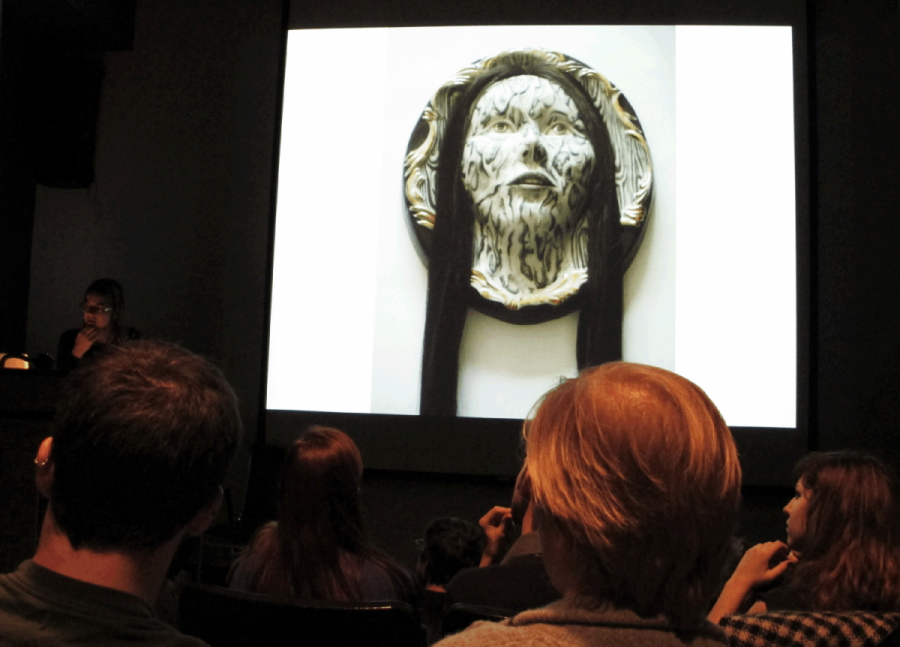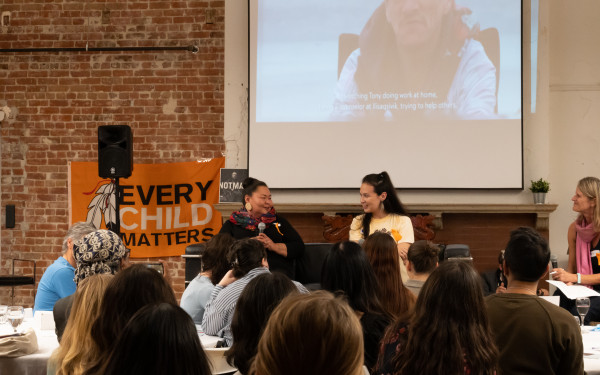Art & Life at the Edge of a Continent
Shary Boyle Visits the West Baffin Eskimo Co-op
It’s Friday lunch time. Students are sitting on the floor and on the stairs in the conference room of the VA Building, expecting to see Shary Boyle’s provocative and highly crafted sculptures, paintings and drawings. Instead, she surprised them with the topic of her talk: her three weeks’ residency at the West Baffin Eskimo Co-op last spring.
Cape Dorset is a little town, with a population of roughly 1,000. Surrounded by rocky hills and next to the sea, it’s located on the southern tip of Baffin Island, NU. Boyle considers the area “the last frontier of the untouched.” On her voyage she came across polar bear skins hanging outside, daily water delivery because it’s not possible to have plumbing and $17.00 bottles of orange juice.
Indeed, the people of Cape Dorset live in isolation, facing brutal weather. Today, even though their traditional way of life is gone, they maintain a sense of community.
“They don’t fight, they don’t speak about bad things, they don’t have the courage to do it,” said Boyle. The majority of the people are passive and unemployed. The government doesn’t help enough, and there aren’t many opportunities for them to generate a local economy.
In a place where there is “no university, no college, no money,” how do they sustain themselves? The best way to get money is to make art. While that may not seem like the most lucrative of choices to those in the urbanized southern stretch of the country, the artists have one of the best economic situations in the community.
Cape Dorset is the most renowned and productive Inuit center for art production, particularly carving and printmaking, since the 1950s. When the Baffin Eskimo Co-op was founded in 1959, it was the first art organization in the Canadian Arctic. Today, it’s a graphic arts and stone-cutting centre, as well as the only community store, its significance making it a multimillion-dollar community business.
Anybody can work in the studios, as long as they have the discipline and commitment required. Artists work 9 to 5 and all supplies are provided. They are paid by the hour, but even if the work starts “commercial[ly] minde,d they still have amazing imaginations,” said Boyle.
Lately they have been expanding their techniques, using up-to-date materials like oil sticks and large coloured papers. During her residency, Boyle proposed to local artist Shuvinai Ashoona that they make a collaborative drawing. Due to the co-op’s system, in the end Boyle herself had to pay Ashoona the hours she worked on the drawing, but she felt that it ultimately paid off in the difference she experienced.
All the work done at the co-op is sold in advance. Almost all the pieces are bought by renowned galleries in the south such as Toronto’s Feheley Fine Arts, but “the artist doesn’t see any of that money,” said Boyle.
The money isn’t the only thing that isn’t getting through. The pieces that don’t get sold are typically those showing a critical view of life up north. Those pieces are a documentation of part of the community and the history of the place, kept in the co-op as an archive. Several social problems come through in the work—poverty, violence, weapons, drugs and alcohol, spousal and child abuse, young people engrossed by technology and families buying food in stores instead of hunting.
Boyle hopes at one point a museum will finally show them, the hidden facts finally revealed, juxtaposing the idealization of the Inuit identity against their real everyday experiences.
Boyle also showed a glimpse of that intriguing reality. It took her more than two years to convince the people of Cape Dorset that she was a trustworthy person and she genuinely wanted to go, but now has friends there and wants to return.
During her residency, some members of the community would come and quietly watch her drawing, an exchange of feelings clearer through image than language. Cape Dorset is a place where creativity and social conflict are in constant struggle, the community’s valuable artistic assets shining through despite its seclusion and its troubled existence.


_600_832_s.png)

_600_375_90_s_c1.jpg)

